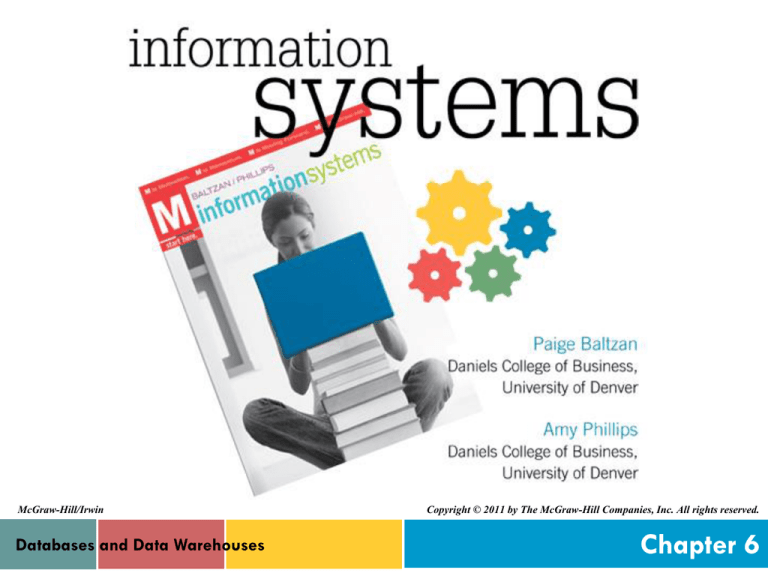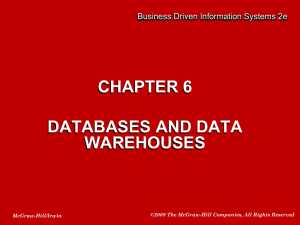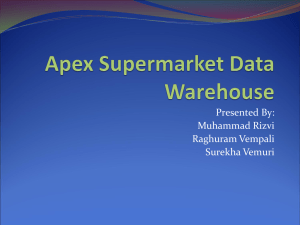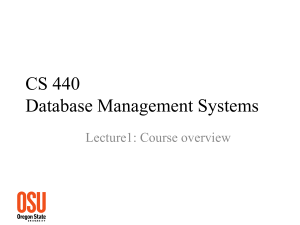
McGraw-Hill/Irwin
Databases and Data Warehouses
Copyright © 2011 by The McGraw-Hill Companies, Inc. All rights reserved.
Chapter 6
SECTION 6.1
Chapter 6
DATABASE FUNDAMENTALS
6-3
ORGANIZATIONAL INFORMATION
Chapter 6
• Information is everywhere in an organization
• Employees must be able to obtain and analyze the
many different levels, formats, and granularities of
organizational information to make decisions
• Successfully collecting, compiling, sorting, and
analyzing information can provide tremendous insight
into how an organization is performing
6-6
ORGANIZATIONAL INFORMATION
Chapter 6
6-7
THE VALUE OF TRANSACTIONAL
AND ANALYTICAL INFORMATION
Chapter 6
6-8
THE VALUE OF TIMELY
INFORMATION
Chapter 6
• Real-time information
• Real-time system
6-9
THE VALUE OF QUALITY INFORMATION
Chapter 6
• Accuracy
• Completeness
• Consistency
• Uniqueness
• Timeliness
6-11
UNDERSTANDING THE COSTS OF
POOR INFORMATION
Chapter 6
• Inability to accurately track customers
• Difficulty identifying valuable customers
• Inability to identify selling opportunities
• Marketing to nonexistent customers
• Difficulty tracking revenue
• Inability to build strong customer relationships
6-14
UNDERSTANDING THE BENEFITS OF
GOOD INFORMATION
Chapter 6
• Improve the chances of making a good decision
6-15
Chapter 6
RELATIONAL DATABASE
RELATIONAL DATABASE
FUNDAMENTALS
Chapter 6
• Relational database model
6-16
RECORDS, FIELDS, AND TABLES
Chapter 6
• Entity (object, record)
• Attribute (field, column)
• Table (class)
6-18
KEYS AND RELATIONSHIPS
Chapter 6
• Relationship
• Primary key
• Foreign key
6-19
CONSTRAINTS
Chapter 6
• Validation rule
• Referential integrity
6-19
RELATIONAL DATABASE
ADVANTAGES
Chapter 6
• Increased flexibility
• Increased scalability and performance
• Reduced information redundancy
6-21
RELATIONAL DATABASE
ADVANTAGES
Chapter 6
• Increased flexibility
• Increased scalability and performance
• Reduced information redundancy
• Increased information integrity (quality)
• Increased information security
6-21
DATABASE MANAGEMENT SYSTEM
Chapter 6
DBMS
DDL
DML
DQL
Structured Query
Language
User Tables
Data
Dictionary
DATABASE MANAGEMENT SYSTEMS
Chapter 6
6-27
DATA-DRIVEN WEBSITES
Chapter 6
6-29
DATA-DRIVEN WEBSITE
BUSINESS ADVANTAGES
Chapter 6
• Content Management
• Future Expandability
• Minimize Human Error
6-30
DATA-DRIVEN WEBSITE
BUSINESS ADVANTAGES
Chapter 6
• Content Management
• Future Expandability
• Minimize Human Error
• Cut Production and Update Costs
• Efficient
• Stability
6-30
SECTION 6.2
Chapter 6
DATA WAREHOUSE
FUNDAMENTALS
6-36
DATA WAREHOUSE FUNDAMENTALS
Chapter 6
• Data warehouse
• Data mart
6-40
EXTRACTION, TRANSFORMATION, AND
LOADING (ETL)
Chapter 6
6-42
INFORMATION CLEANSING OR
SCRUBBING
Chapter 6
6-45
MULTIDIMENSIONAL ANALYSIS
Chapter 6
• In a data warehouse and data mart, information is
multidimensional, it contains layers of columns and
rows
6-43
DATA MINING AND BUSINESS
INTELLIGENCE
Chapter 6
• Data-mining tools helps users uncover business
intelligence
6-50
Chapter 6






